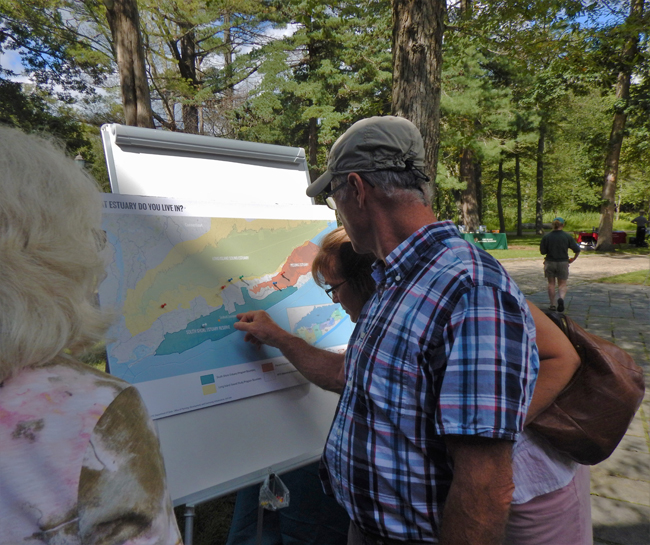A first-collaborative Estuary Day event for Long Island helped bring awareness of estuarine benefits to local community members
Contact:
Anna Weshner-Dunning, NYSG Long Island Sound Study Outreach Coordinator, P: 631-632-8730, E: amw392@cornell.edu
Stony Brook, NY, March 4, 2019 -Estuaries are where freshwater, from rivers or streams, meets ocean saltwater. This unique habitat with surrounding wetlands acts as breeding grounds for fishes and birds and naturally sequesters contaminants. Estuarine health is threatened by elevated nitrogen that can lead to degradation of such ecosystem features as eelgrass beds, saltmarshes, and beaches, and contribute to algal blooms. Educational programming informs the public about the value of local estuaries and encourages citizen support for keeping these natural resources healthy.
In 2018, and for the first time, Long Island’s three estuary programs — the Long Island Sound Study (LISS), Peconic Estuary Program, and South Shore Estuary Reserve — joined resources to develop and conduct Long Island’s first collaborative Estuary Day with a public education focus on nitrogen (N) pollution as a pressing problem on Long Island. The Seatuck Environmental Association at the Suffolk County Environmental Center in Islip served as event host.
This free event provided the public with a better understanding of ways they can help reduce N pollution locally. For example, upgrading antiquated septic systems that may be leaching N, properly disposing of pet waste, planting native plant species that absorb N, and testing soil before applying N fertilizer to lawns and gardens.
This inaugural Estuary Day, with approximately 70 participants, included lectures, workshops, 20 informational exhibits, and family-friendly activities such as beach clean-ups and nature hikes. As a result, Long Island citizens now know more about local efforts to protect Long Island’s natural resources.
The 2018 Long Island Estuary Day was held as part of National Estuaries Week, established by the U.S. Environmental Protection Agency. The LISS will serve as lead organizer for the 2019 Estuary Day in Oyster Bay.
“Continual coordination between the three Long Island programs to communicate the major water quality issues facing Long Island coastal waters and the on-going development of solutions to these issues is of the utmost importance to the future of these waterbodies and Long Island communities.” — Joyce Novak, Director, Peconic Estuary Program

Estuary Day 2018 visitors check a map of Long Island’s South Shore Estuary Reserve that extends 75 miles and supports a large contingent of water-dependent businesses. Credit: NYSDEC.
Partners:
• Long Island Sound Study
• New York State Department of Environmental Conservation
• Peconic Estuary Program
• Seatuck Environmental Association
• South Shore Estuary Reserve
More Info: New York Sea Grant
New York Sea Grant (NYSG), a cooperative program of Cornell University
and the State University of New York (SUNY), is one of 33 university-based
programs under the National Oceanic and Atmospheric Administration’s
National Sea Grant College Program.
Since 1971, NYSG has represented a statewide network of integrated
research, education and extension services promoting coastal community
economic vitality, environmental sustainability and citizen awareness
and understanding about the State’s marine and Great Lakes resources.
Through NYSG’s efforts, the combined talents of university scientists
and extension specialists help develop and transfer science-based
information to many coastal user groups—businesses and industries,
federal, state and local government decision-makers and agency managers,
educators, the media and the interested public.
The program maintains Great Lakes offices at Cornell University, SUNY
Buffalo, SUNY Oswego and the Wayne County Cooperative Extension office
in Newark. In the State's marine waters, NYSG has offices at Stony Brook
University in Long Island, Brooklyn College and Cornell Cooperative
Extension in NYC and Kingston in the Hudson Valley.
For updates on Sea Grant activities: www.nyseagrant.org has RSS, Facebook, Twitter, and YouTube links. NYSG offers a free e-list sign up via www.nyseagrant.org/nycoastlines for its flagship publication, NY Coastlines/Currents, which is published quarterly. Our program also produces an occasional e-newsletter,"NOAA Sea Grant's Social Media Review," via its blog, www.nyseagrant.org/blog.